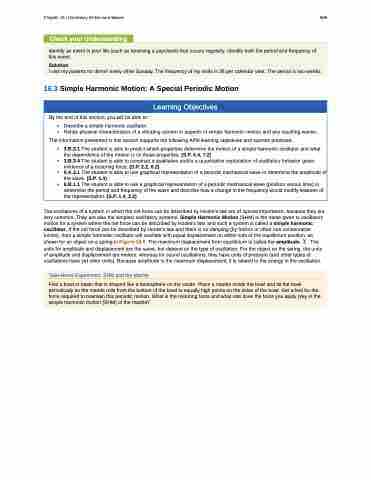Page 701 - College Physics For AP Courses
P. 701
Chapter 16 | Oscillatory Motion and Waves 689
Check your Understanding
Identify an event in your life (such as receiving a paycheck) that occurs regularly. Identify both the period and frequency of this event.
Solution
I visit my parents for dinner every other Sunday. The frequency of my visits is 26 per calendar year. The period is two weeks.
16.3 Simple Harmonic Motion: A Special Periodic Motion
Learning Objectives
By the end of this section, you will be able to:
• Describe a simple harmonic oscillator.
• Relate physical characteristics of a vibrating system to aspects of simple harmonic motion and any resulting waves.
The information presented in this section supports the following AP® learning objectives and science practices:
• 3.B.3.1 The student is able to predict which properties determine the motion of a simple harmonic oscillator and what the dependence of the motion is on those properties. (S.P. 6.4, 7.2)
• 3.B.3.4 The student is able to construct a qualitative and/or a quantitative explanation of oscillatory behavior given evidence of a restoring force. (S.P. 2.2, 6.2)
• 6.A.3.1 The student is able to use graphical representation of a periodic mechanical wave to determine the amplitude of the wave. (S.P. 1.4)
• 6.B.1.1 The student is able to use a graphical representation of a periodic mechanical wave (position versus time) to determine the period and frequency of the wave and describe how a change in the frequency would modify features of the representation. (S.P. 1.4, 2.2)
The oscillations of a system in which the net force can be described by Hooke’s law are of special importance, because they are very common. They are also the simplest oscillatory systems. Simple Harmonic Motion (SHM) is the name given to oscillatory motion for a system where the net force can be described by Hooke’s law, and such a system is called a simple harmonic oscillator. If the net force can be described by Hooke’s law and there is no damping (by friction or other non-conservative forces), then a simple harmonic oscillator will oscillate with equal displacement on either side of the equilibrium position, as shown for an object on a spring in Figure 16.9. The maximum displacement from equilibrium is called the amplitude � . The
units for amplitude and displacement are the same, but depend on the type of oscillation. For the object on the spring, the units of amplitude and displacement are meters; whereas for sound oscillations, they have units of pressure (and other types of oscillations have yet other units). Because amplitude is the maximum displacement, it is related to the energy in the oscillation.
Take-Home Experiment: SHM and the Marble
Find a bowl or basin that is shaped like a hemisphere on the inside. Place a marble inside the bowl and tilt the bowl periodically so the marble rolls from the bottom of the bowl to equally high points on the sides of the bowl. Get a feel for the force required to maintain this periodic motion. What is the restoring force and what role does the force you apply play in the simple harmonic motion (SHM) of the marble?


